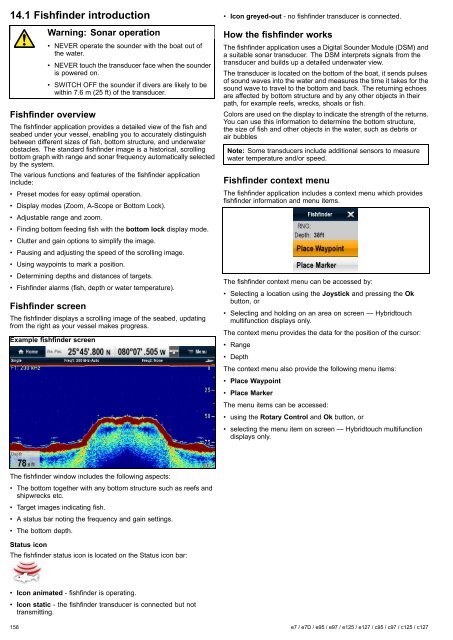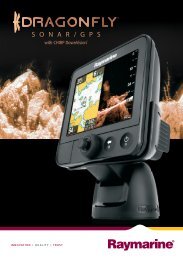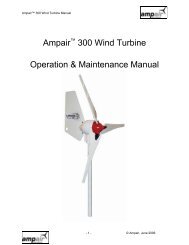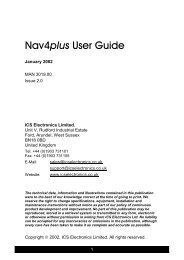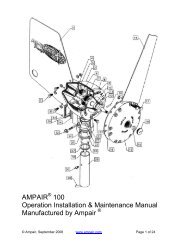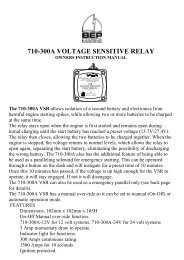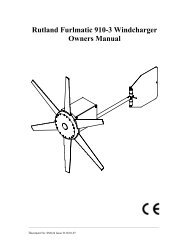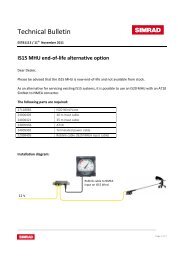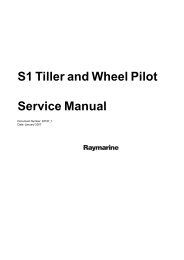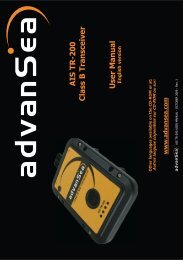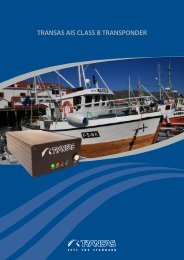User manual - JG Technologies
User manual - JG Technologies
User manual - JG Technologies
You also want an ePaper? Increase the reach of your titles
YUMPU automatically turns print PDFs into web optimized ePapers that Google loves.
14.1 Fishfinder introduction<br />
Warning: Sonar operation<br />
• NEVER operate the sounder with the boat out of<br />
the water.<br />
• NEVER touch the transducer face when the sounder<br />
is powered on.<br />
• SWITCH OFF the sounder if divers are likely to be<br />
within 7.6 m (25 ft) of the transducer.<br />
Fishfinder overview<br />
The fishfinder application provides a detailed view of the fish and<br />
seabed under your vessel, enabling you to accurately distinguish<br />
between different sizes of fish, bottom structure, and underwater<br />
obstacles. The standard fishfinder image is a historical, scrolling<br />
bottom graph with range and sonar frequency automatically selected<br />
by the system.<br />
The various functions and features of the fishfinder application<br />
include:<br />
• Preset modes for easy optimal operation.<br />
• Display modes (Zoom, A-Scope or Bottom Lock).<br />
• Adjustable range and zoom.<br />
• Finding bottom feeding fish with the bottom lock display mode.<br />
• Clutter and gain options to simplify the image.<br />
• Pausing and adjusting the speed of the scrolling image.<br />
• Using waypoints to mark a position.<br />
• Determining depths and distances of targets.<br />
• Fishfinder alarms (fish, depth or water temperature).<br />
Fishfinder screen<br />
The fishfinder displays a scrolling image of the seabed, updating<br />
from the right as your vessel makes progress.<br />
Example fishfinder screen<br />
• Icon greyed-out - no fishfinder transducer is connected.<br />
How the fishfinder works<br />
The fishfinder application uses a Digital Sounder Module (DSM) and<br />
a suitable sonar transducer. The DSM interprets signals from the<br />
transducer and builds up a detailed underwater view.<br />
The transducer is located on the bottom of the boat, it sends pulses<br />
of sound waves into the water and measures the time it takes for the<br />
sound wave to travel to the bottom and back. The returning echoes<br />
are affected by bottom structure and by any other objects in their<br />
path, for example reefs, wrecks, shoals or fish.<br />
Colors are used on the display to indicate the strength of the returns.<br />
You can use this information to determine the bottom structure,<br />
the size of fish and other objects in the water, such as debris or<br />
air bubbles<br />
Note: Some transducers include additional sensors to measure<br />
water temperature and/or speed.<br />
Fishfinder context menu<br />
The fishfinder application includes a context menu which provides<br />
fishfinder information and menu items.<br />
The fishfinder context menu can be accessed by:<br />
• Selecting a location using the Joystick and pressing the Ok<br />
button, or<br />
• Selecting and holding on an area on screen — Hybridtouch<br />
multifunction displays only.<br />
The context menu provides the data for the position of the cursor:<br />
• Range<br />
• Depth<br />
The context menu also provide the following menu items:<br />
• Place Waypoint<br />
• Place Marker<br />
The menu items can be accessed:<br />
• using the Rotary Control and Ok button, or<br />
• selecting the menu item on screen — Hybridtouch multifunction<br />
displays only.<br />
The fishfinder window includes the following aspects:<br />
• The bottom together with any bottom structure such as reefs and<br />
shipwrecks etc.<br />
• Target images indicating fish.<br />
• A status bar noting the frequency and gain settings.<br />
• The bottom depth.<br />
Status icon<br />
The fishfinder status icon is located on the Status icon bar:<br />
• Icon animated - fishfinder is operating.<br />
• Icon static - the fishfinder transducer is connected but not<br />
transmitting.<br />
158 e7 / e7D / e95 / e97 / e125 / e127 / c95 / c97 / c125 / c127


